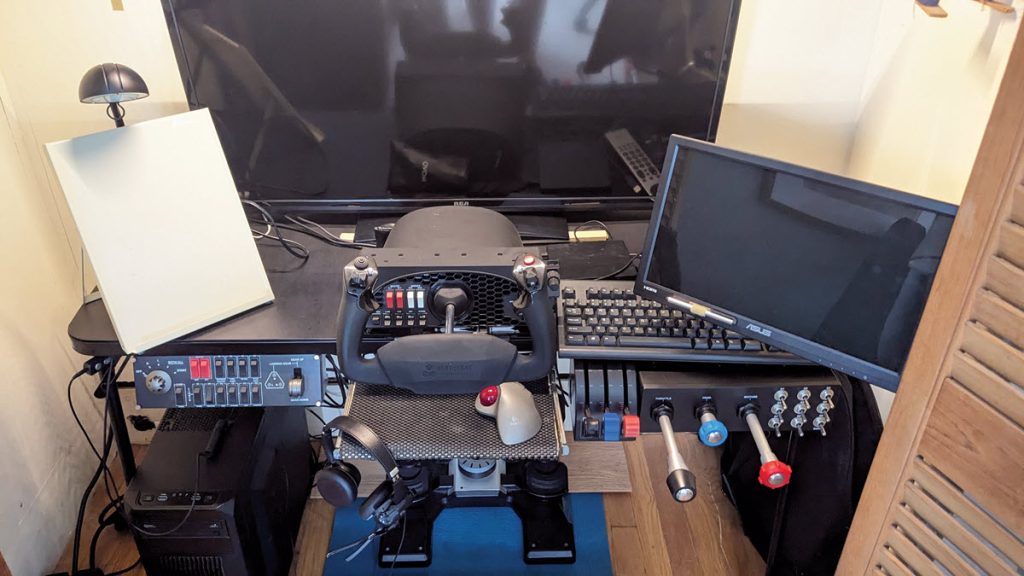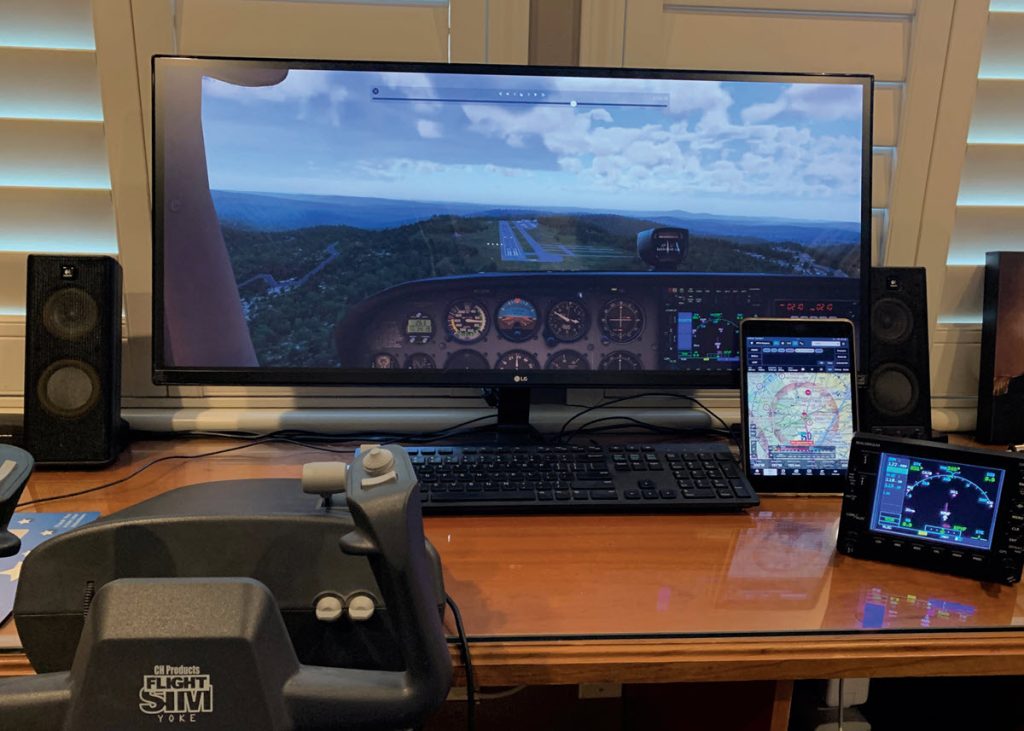
By Dan Brownell
Flight simulators have been widely used for many years, from desktop recreational use through high-end commercial pilot training. Microsoft Flight Simulator hit the market in 1982 and has been an industry leader for the general public since then and continues to be a favorite for general aviation pilots.
Over the years, companies have introduced increasingly sophisticated flight simulator technology for GA and commercial pilots. In commercial aviation, the FAA classifies simulators as full flight simulators (FFS) or flight training devices (FTD).
General aviation pilots can use home or flight school simulators for general training and maintaining proficiency. Some GA simulators even meet FAA requirements for logging legally recognized flight time. They’re classified as basic aviation training devices (BATDs) and advanced aviation training devices (AATDs). Because of the costs involved, BATDs are generally used in home setups, while AATDs are typically used by flight schools, although some GA pilots are willing to invest in AATDs for home use.
Simulator Integration, Fidelity, and Cost
Flight simulators are a collection of physical hardware components and computer software that must be compatible and integrated into a consistently reliable system in all flight functions and parameters. Whether the system is created by a commercial vendor or home enthusiast, the fidelity of a sim (its ability to faithfully reproduce flight characteristics and avionics performance) will depend on the effectiveness of the integration. Matching aircraft response to actual physical control movements, reproducing all avionics functions, and adding control force feedback or motion all contribute to the fidelity/cost equation.
—Mike Jones
FAA Advisory Circular AC 61-136B provides guidance for BATDs and AATDs under 14 CFR, Part 61.4(c). The advisory covers requirements for manufacturer approval and for individuals using these devices for pilot training and experience. This advisory applies only to the evaluation and use of BATDs and AATDs, not to the FFS and FTD simulators used for commercial pilot training under 14 CFR part 60. The advisory includes a downloadable PDF listing the various current approved BATD and AATD simulator manufacturers, simulator names, and approved aircraft configurations.
Following are the results received from the member survey on flight simulators. Because of space restrictions, not all comments were included.
Microsoft Flight Simulator X
What are the pros of your system?
It’s easy to set up and works well with ForeFlight on an iPad. This is a great way to keep sharp. I have saved several approaches, and this allows 10 or more approaches in less than an hour.
—Don Kudner, 1956 170B
The actual flying isn’t super realistic, but with the controls closely matching the real plane and using live ATC through PilotEdge, it’s great for procedures practice.
—David Dentry, 2006 T182T
The cost.
—Hameed Afzal, 1986 172P
What are the cons of your system?
You don’t feel the plane, but otherwise, flies just like my plane.
—Don Kudner, 1956 170B
If budget isn’t a big issue, just buy an approved sim. Once you’re “all in” on a build-it-yourself model, you’re likely more than halfway to a sim you can actually log hours in.
—David Dentry, 2006 T182T
It’s not FAA approved.
—Hameed Afzal, 1986 172P
What advice would you offer a member who wants to purchase a first flight simulator or perhaps upgrade to a more advanced one?
Turn the scenery’s setting and visibility down and Microsoft or X-Plane will be great practice aids, even on a marginal computer.
—Don Kudner, 1956 170B
Microsoft Flight Simulator 2020
What are the pros of your system?
Hardware is expensive. Sim is cheap.
—Raymond Brach, 1966 182
It’s reasonably realistic, and it’s cheaper and more convenient than actual flights. You can perform high-risk activities and experience the results. You can also repeat challenges and situations without the delays of setting them up in the real world. It may be an unpopular opinion, but I’ll say that you can use this in your primary training and not ruin your actual training.
—David Wyatt, 1965 182H
What are the cons of your system?
Waiting for Microsoft FS 2024.
—Raymond Brach, 1966 Cessna 182
It takes up space and has some setup time. The system doesn’t exactly mirror my actual setup but is similar enough to suffice. You can spend more time on configuring than flying, so be thoughtful on how complex you go.
—David Wyatt, 1965 182H
What advice would you offer a member who wants to purchase a first flight simulator or perhaps upgrade to a more advanced one?
Microsoft. Period.
—Raymond Brach, 1966 182
Do a good amount of research and establish a plan to save and purchase the system you want. Read articles and watch YouTube videos that show how to create the most realistic experience available.
—Robert Taylor, 1975 Cessna 150M
Start simple and then work your way up from there. Identify what you want to get from your flight simulator: training, discovery, proficiency, use of EFBs, and what will keep you engaged and enjoying the simulator. You can get stuck by doing too many add-ons and then spend your time making them all work versus actually flying, so be thoughtful and read through the community support boards to see the better picture if the add-on works well, and what level of complexity is involved with its integration.
—David Wyatt, 1965 182H

Redbird TD
What are the pros of your system?
My Redbird TD is a great machine to simulate my Skyhawk. It provides very good graphics and accurate, realistic responses. The buttons are real, not touchscreen, so the muscle memory is well learned. It connects to my ForeFlight as if I was in the aircraft, aiding my iPad skills as well.
The system is all-inclusive, although I did opt for Logitech rudder pedals vs. the Redbird ones, simply for the cost. It’s an excellent platform to preview a new airport I’m planning on going into, and the navigation system emulates a Garmin 530 very well.
—Dave Cohen, 1967 172H
What are the cons of your system?
This is not for the faint-of-wallet. It’s a shade under $10,000, as I have mine configured, to include the table. It is not light, nor portable, and do not throw away the boxes, even if you swear up and down that you’ll never move.
—Dave Cohen, 1967 172H
What advice would you offer a member who wants to purchase a first flight simulator or perhaps upgrade to a more advanced one?
Figure out what you want to do with your sim. If it’s just to play, then a PC-based MS or X-Plane product is fine. If you’re looking at currency and proficiency, though, realize that the money isn’t just a cost — it’s an investment.
—Dave Cohen, 1967 172H
Redbird TD2
What are the pros of your system?
It’s feature rich and has great performance. It is easy to turn on and load up an approach to maintain my instrument currency.
—Joshua Lessmeister, 1998 182S
It features good graphics and good G1000 simulation, with fair controls simulation. My airplane has a G3X, GTN 750, and G500. It’s similar enough to the G1000 that crossover is easy. Also, this has real knobs and buttons. I got it used, less than half of its value new. It’s a great way to keep current and to fly IFR practice to an airport before the actual trip. It’s much better than my first simulator, which only had a touchscreen. On the other hand, my first simulator could simulate multiple Cessnas and configurations.
I really like the ability to maintain currency. It pays for itself pretty quickly. As I have only had two sims, both certified, I’m not able to say much about the non-certified sims. They do look like fun!
—James Felts, 1979 TR182
The pros are that I can log instrument approaches and holds in the comfort of my own home. I also like to use it on various runways of new airports that I’m going to. I can do their approaches before I actually have to do them in real life. Redbird also has training that’s available that puts you in scenarios of some pretty tough IFR approaches. I find this to be very beneficial.
—Ken Ouellette, 1976 206
What are the cons of your system?
The only con I can truly think of is the total cost and maybe graphics. It’s a simulator. It’s going to be expensive, and the graphics aren’t going to be the best, considering one can legally use it for proficiency and training.
—Joshua Lessmeister, 1998 182S
Some of the panel isn’t exactly like my own aircraft. It’s still usable, though. It just takes some modification.
—Ken Ouellette, 1976 206
What advice would you offer a member who wants to purchase a first flight simulator or perhaps upgrade to a more advanced one?
Do your research and find one that best suits your budget and layout.
—Joshua Lessmeister, 1998 182S
I would ask what you want to use it for. A Microsoft-type simulator is great for practicing some approaches, although you can’t log those approaches. I find mine good for keeping current as I’m in kind of a rural area where it’s hard to get an instructor.
—Ken Ouellette, 1976 206
X-Plane 11
The rest of this article can be seen only by paid members who are logged in.Have a website login already? Log in and start reading now.
Never created a website login before? Find your Customer Number (it’s on your mailing label) and register here.
JOIN HERE
Still have questions? Contact us here.







